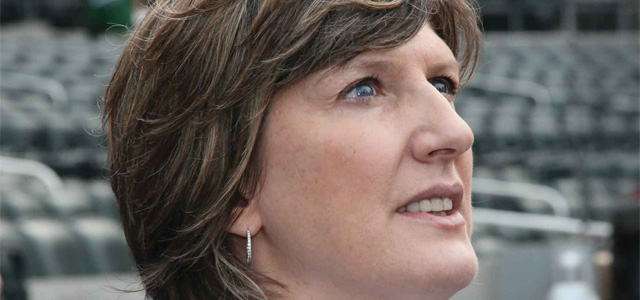Professor Roberta Devlin-Scherer shows her education students firsthand how technology improves classroom learning.
In conversations about kids and screen time, few experts are arguing that young people might benefit from more time in front of the computer. But one scholar in the College of Education and Human Services says games can help kids develop critical thinking, problem-solving, and reading comprehension skills — while engaging a generation of “digital natives.”
“When we hear ‘gaming,’ we first may think of violent games like Mortal Kombat,” says education professor Roberta Devlin-Scherer. “But SimCity or Ayiti: The Cost of Life are really learning games.”
In Ayiti, players help a family navigate life in rural Haiti. Games like PeaceMaker and Peace Doves explore international relations through the lenses of the Israeli-Palestinian conflict and global nuclear proliferation. Other games teach literary analysis, finance and mathematics, current events and media literacy, among other subjects.
The University’s 2013 nominee for CASE/Carnegie Foundation U.S. Professor of the Year, Devlin-Scherer emphasizes the importance of teachers helping students navigate the online world.
“We are teaching them to be digital citizens, to be responsible, to use the technology to improve their situations,” she says. “Teachers can talk honestly to kids, and say, ‘How are you managing? You don’t want to miss out on being outside. Make sure you balance your life.’”
Of course, teachers have long used games in classrooms to engage kids in learning and add variety to lesson plans. But most of today’s students have never known a world without Internet and smartphones, and video games are a natural fit for a learning style that is visual, interactive and provides immediate gratification.
“The reality is, whether we like it or not, our students are episodic, used to short TV shows and to switching between Internet screens: They’re multitaskers and have a difficult time going deep,” says Julie Carlson ’13, a first-year social-studies teacher at Pequannock Township High School in Pompton Plains, N.J. “We want to harness these games and devices in order to motivate them to go deep — to create a buy-in for students so they’re willing to use technology in a positive way.”
Carlson cites the mini-videos she and her classmates created in Devlin-Scherer’s sophomore-level Instructional Theory Into Practice course. During the semester, Devlin-Scherer recorded the students presenting lessons to their peers, providing immediate feedback on body language, projected confidence and clarity. At the end of the course, they made short videos in which they reflected on their progress and plans.
“Seeing how much I’d improved over the semester was not only instructive but was also encouraging,” Carlson recalls. “That’s something that’s hard to measure in teaching.”
The mini-video project epitomizes Devlin-Scherer’s use of technology as a tool for learning. “I’m looking for ways to present information that is more unique, interesting, creative, and engaging,” she says. “Technology lets you combine tools, skills and ideas together.”
In flickering sepia tone, a young woman exits a train terminal, glances at her map, and strides purposefully forward. Titles appear across the bottom of the screen: “I accomplished so much since I came to this country.” As the image changes to color, the same young woman stands at the front of a classroom. “Becoming a Spanish teacher is my American dream,” Solange Sandel ’13 says in voiceover.
The shift in tone from nostalgic to cutting-edge mirrored her experience under Devlin-Scherer’s mentorship, Sandel says. “The future did not just represent me, but what I could do for the next generation of students,” she observed. “Seton Hall is like that, the best of both worlds: tradition, while always looking toward the future.”
Today Sandel is a first-year Spanish teacher at West Morris Mendham High School in Mendham, N.J., where she uses many of the computer and mobile apps taught in Devlin-Scherer’s courses. She has been told that she is the first teacher there to use this technology.
The assessment is echoed time and again by Devlin-Scherer’s students: that she is preparing them both for the near future and the changing world ahead.
“Professor Devlin-Scherer — and the education program at Seton Hall as a whole — were very focused on where education is going to be next year, and what our teachers need to know in order to be prepared when they graduate,” Carlson says. “Technology is the way it’s going; education, in fact, is behind society as a whole in terms of technology. Having experienced the benefits of technology in my own education helps me better use it for my students.”
Tricia Brick is a New York-area writer.







